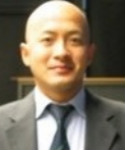| Biography | |
|---|---|
 Prof. Shigang Yue University of Lincoln, UK |
|
| Title: Secrets of seeing the dynamic world - from motion sensitive visual neurons to bio-robots | |
| Abstract: Animals, as small as insects, have amazing ability in exploring within this dynamic visual world. This ability has not been observed in or easy to implement to human made intelligent moving machines such as robots. By modelling bio-plausible neural networks, we can not only contribute to further understanding of how animals visual systems or particular visual neurons work, but also step forward in developing new intelligent vision systems fit for future robots. In this talk, I will introduce the most recent work in my group on modelling specific motion sensitive visual neurons in insects which are excellent in responding to dynamic visual world. I will share with you the secrets behind these amazing motion sensitive neural networks and the new implementation in mobile and swarm robots.
Prof. Shigang Yue home pages http://webpages.lincoln.ac.uk/syue http://www.ciluk.org/syue (most updated)
| |
| Biography:
Shigang Yue is a Professor (since 2012) in the School of Computer Science, University of Lincoln, United Kingdom. He received his PhD and MSc degrees from Beijing University of Technology (BJUT) in 1996 and 1993, and his BEng degree from Qingdao Technological University (1988). He worked in BJUT as a Lecturer (1996-1998) and an Associate Professor (1998-1999), also in City University of Hong Kong (MEEM) as a Senior Research Assitant (1998-1999). He was an Alexander von Humboldt Research Fellow (2000, 2001) working with Prof. Henrich in the Faculty of Computer Science, University of Kaiserslautern, Germany. Before joining the University of Lincoln as a Senior Lecturer (2007) and promoted to a Reader (2010), he held research positions in the University of Cambridge (2006-2007), Newcastle University (2003-2006) and the University College London (UCL) (2002-2003) respectively.
His research interests are mainly within the field of artificial intelligence, computer vision, robotics, brains, and neuroscience. He is particularly interested in biological visual neural systems, evolving of neural subsystems, neuromorphic vision chip and its applications in collision detection for vehicles, interactive systems, UAVs and ground robots. He has pioneered the area of using further organisations of directional selective neural networks for collision detection. He also has research interest in medical image analysis established in Cambridge, including DTI/fMRI and endoscopic image analysis. He prefers multidisciplinary approaches in research.
He has published more than 100 journal and conference papers in information theory, computer vision, artificial life, neural systems, neural evolution, swarm intelligence, vehicle collision detection, robotic navigation, robotic manipulation skills and dynamic simulations, many of them are in top tier high impact journals. He has chaired several international conferences. He is the founding director of the multiple discipliary group CIL in UoL. He is also a reviewer for several reputable international journals and committee member of several international conferences. He is the coordinator for several EU FP7/H2020 projects.
| |
